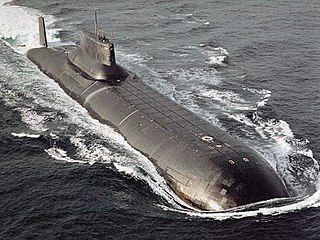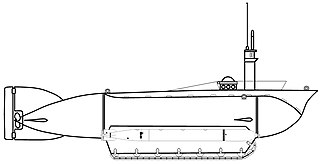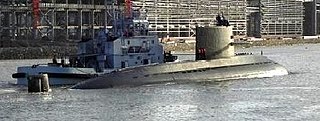| Class overview | |
|---|---|
| Builders: | Jiangnan Shipyard |
| Operators: | |
| General characteristics | |
| Type: | midget submarine |
| Displacement: | 350 tonnes (340 long tons; 390 short tons) |
| Installed power: | Batteries & diesel |
| Propulsion: | Electric motor & diesel engine |
| Speed: | 12 knots (22 km/h; 14 mph) |
| Armament: | 4 torpedoes |
Type 030 submarine was a mini submarine developed by the People's Liberation Army Navy (PLAN) in the mid 1960s, and only a single unit was built. However, before the first unit could be completed, the program was cancelled in the early 1970s, and the unfinished hull was scrapped. [1]

A submarine is a watercraft capable of independent operation underwater. It differs from a submersible, which has more limited underwater capability. The term most commonly refers to a large, crewed vessel. It is also sometimes used historically or colloquially to refer to remotely operated vehicles and robots, as well as medium-sized or smaller vessels, such as the midget submarine and the wet sub. The noun submarine evolved as a shortened form of submarine boat; by naval tradition, submarines are usually referred to as "boats" rather than as "ships", regardless of their size.

The People's Liberation Army Navy, also known as the PLA Navy, is the naval warfare branch of the People's Liberation Army, which is the armed wing of the Communist Party of China and, by default, the national armed forces of the People's Republic of China. The PLAN can trace its lineage to naval units fighting during the Chinese Civil War and was established in September 1950. Throughout the 1950s and early 1960s, the Soviet Union provided assistance to the PLAN in the form of naval advisers and export of equipment and technology. Until the late 1980s, the PLAN was largely a riverine and littoral force. However, by the 1990s, following the fall of the Soviet Union and a shift towards a more forward-oriented foreign and security policy, the leaders of the Chinese military were freed from worrying over land border disputes, and instead turned their attention towards the seas. This led to the development of the People's Liberation Army Navy into a green-water navy by 2009. Before the 1990s the PLAN had traditionally played a subordinate role to the People's Liberation Army Ground Force.
After Sino-Soviet split, China realized its navy, PLAN, was no match for the Soviet navy, and in the event of Soviet invasion, PLAN has to withdraw to coastal waters and even inland waterways to fight a guerrilla warfare against the much stronger opponent, [1] [2] so smaller submarines such as mini or midget subs are much more suited for fighting the underwater guerrilla war. In addition, smaller subs were also able to be mass-produced. [1] [3] In 1964, the deputy commander-in-chief of PLAN, Vice admiral Zhao Qi-Min (赵启民) formally issued the order to develop a mini/midget submarine, and the 701st Research Institute of China Shipbuilding Industry Corporation (CSIC) was tasked to issue the requirement, which eventually named as Type 030 in 1965 when the winning design was selected from several proposals. [1] [2]

The Sino-Soviet split (1956–1966) was the breaking of political relations between the People's Republic of China (PRC) and the Union of Soviet Socialist Republics (USSR), caused by doctrinal divergences that arose from their different interpretations and practical applications of Marxism–Leninism, as influenced by their respective geopolitics during the Cold War. In the late 1950s and early 1960s, Sino-Soviet debates about the interpretation of Orthodox Marxism became specific disputes about the Soviet Union's policies of national de-Stalinization and international peaceful coexistence with the Western world. Against that political background, the international relations of the PRC featured official belligerence towards the West, and an initial, public rejection of the Soviet policy of peaceful coexistence between the Eastern and Western blocs, which Mao Zedong said was Marxist revisionism by the Russian communists.
Vice admiral is a senior naval flag officer rank, equivalent to lieutenant general and air marshal. A vice admiral is typically senior to a rear admiral and junior to an admiral. In many navies, vice admiral is a three-star rank with a NATO code of OF-8, although in some navies like the French Navy it is an OF-7 rank, the OF-8 code corresponding to the four-star rank of squadron vice-admiral.

The China Shipbuilding Industry Corporation (CSIC) is one of the two largest shipbuilding conglomerates in China, the other being the China State Shipbuilding Corporation (CSSC). It was formed by the Government of the People's Republic of China on 1 July 1999 from companies spun off from CSSC, and is 100% owned by SASAC. Headquartered in Beijing, the CSIC handles shipbuilding activities in the north and the west of China, while the China State Shipbuilding Corporation (CSSC) deals with those in the east and the south of the country.
Because the mini/midget sub was intended to operate in riverine and coastal region, the speed requirement is only 12 kt max, and hence propulsion requirement of the boat only rated at 320 kW. [4] The general designer of Type 030 was Mr. Li Jian-Qiu (李建球), the general designer of Type 033G/G1. [1] [5] However, due to the unrealistic requirement of packing large amount of equipment and weaponry into a very small hull, the internal space is very cramped and production had to be stopped several time for redesign. [1] [5] As a result, production was protracted, with the first boat was still not completed in the early 1970s after construction begun in June 1968, and as PLAN changed its doctrine in the early 1970s, midget or mini submarine was no longer a priority, and in 1973, the program was finally cancelled by PLAN, and with the successful development of larger Type 033 and Type 035, the unfinished first unit was broken up and scrapped. [1] [6] The electric motor of Type 030 was kept at the PLAN Naval Engineering University for exhibition. [1] [7]
The Type 035 submarine is a class of diesel-electric submarines of the People's Liberation Army Navy. The Type 035 is a heavily improved redesign of the older Type 033 Romeo-class submarines, which were built in China from 1962 to 1984.









